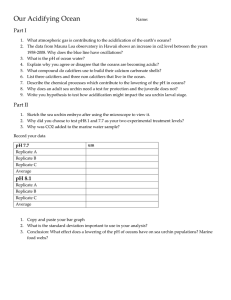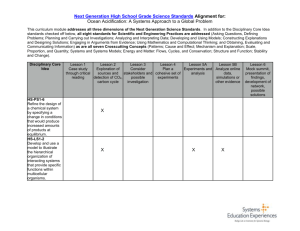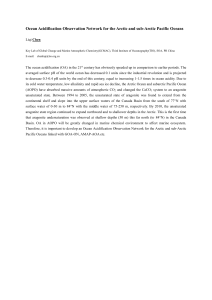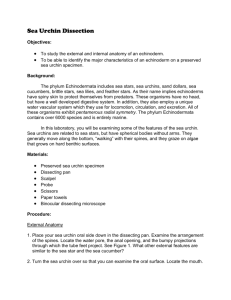Virtual Urchin Guide
advertisement
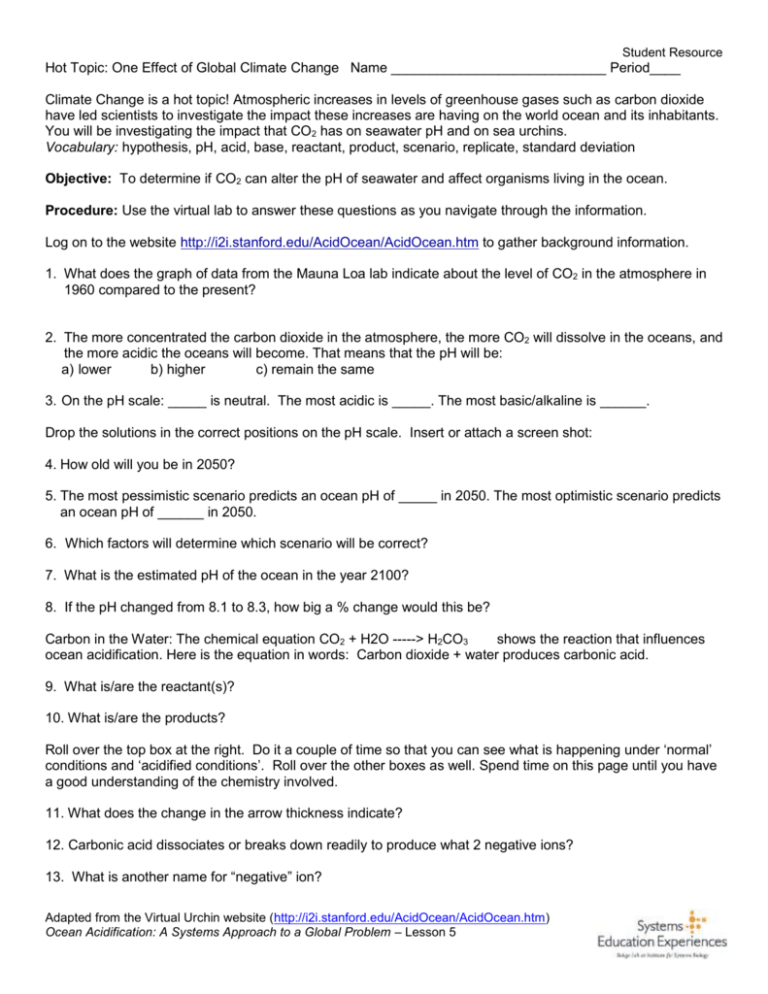
Student Resource Hot Topic: One Effect of Global Climate Change Name ____________________________ Period____ Climate Change is a hot topic! Atmospheric increases in levels of greenhouse gases such as carbon dioxide have led scientists to investigate the impact these increases are having on the world ocean and its inhabitants. You will be investigating the impact that CO2 has on seawater pH and on sea urchins. Vocabulary: hypothesis, pH, acid, base, reactant, product, scenario, replicate, standard deviation Objective: To determine if CO2 can alter the pH of seawater and affect organisms living in the ocean. Procedure: Use the virtual lab to answer these questions as you navigate through the information. Log on to the website http://i2i.stanford.edu/AcidOcean/AcidOcean.htm to gather background information. 1. What does the graph of data from the Mauna Loa lab indicate about the level of CO2 in the atmosphere in 1960 compared to the present? 2. The more concentrated the carbon dioxide in the atmosphere, the more CO2 will dissolve in the oceans, and the more acidic the oceans will become. That means that the pH will be: a) lower b) higher c) remain the same 3. On the pH scale: _____ is neutral. The most acidic is _____. The most basic/alkaline is ______. Drop the solutions in the correct positions on the pH scale. Insert or attach a screen shot: 4. How old will you be in 2050? 5. The most pessimistic scenario predicts an ocean pH of _____ in 2050. The most optimistic scenario predicts an ocean pH of ______ in 2050. 6. Which factors will determine which scenario will be correct? 7. What is the estimated pH of the ocean in the year 2100? 8. If the pH changed from 8.1 to 8.3, how big a % change would this be? Carbon in the Water: The chemical equation CO2 + H2O -----> H2CO3 shows the reaction that influences ocean acidification. Here is the equation in words: Carbon dioxide + water produces carbonic acid. 9. What is/are the reactant(s)? 10. What is/are the products? Roll over the top box at the right. Do it a couple of time so that you can see what is happening under ‘normal’ conditions and ‘acidified conditions’. Roll over the other boxes as well. Spend time on this page until you have a good understanding of the chemistry involved. 11. What does the change in the arrow thickness indicate? 12. Carbonic acid dissociates or breaks down readily to produce what 2 negative ions? 13. What is another name for “negative” ion? Adapted from the Virtual Urchin website (http://i2i.stanford.edu/AcidOcean/AcidOcean.htm) Ocean Acidification: A Systems Approach to a Global Problem – Lesson 5 14. What positive ion is released which in turn changes the pH? 15. What is another name for a positive ion? The reaction shifts due to excess hydrogen ions to produce increasing amounts of bicarbonate which “ties” up the carbonate that the organisms need. 16. Why do the organisms need the carbonate and the calcium? Use the drawing of the ocean chemistry “Carbon in water” to predict the effect of increasing acidification on calcifying organisms. Exploring carbon levels and effects: Move the slider bar for the years up and down and watch the changes in levels as well as in the coral then make predictions: 18. As the slider is moved into the future, predicted levels of _________and __________ increase while levels of __________ decrease and __________ decreases indicating more acidic conditions. Select each of the 3 scenarios and list the maximum pH for each: Scenario A: Which scenario do you think is most likely to occur? Scenario B: Scenario C: Explain. Diversity of Life in the Sea: Roll over each organism and read the information available. Place each in the appropriate box. Insert or attach a screen shot: Is the sea urchin a calcifier? Explain. Watch the video on urchin development. As you watch the cell begin to divide (cleavage) you see small, jiggling cells surrounding it. What are these? Why would the stage ‘gastrulation’ be named so? What do the pluteus larvae remind you of? How does a juvenile compare to an adult urchin? How to study acidification in the lab: Follow all directions and read everything so you don’t get part way through and have to start over. Make a separate word document as a lab report. If a sea urchin (any part of its life cycle) is exposed to sea water that has a lower pH, how will it be affected? (hypothesis). Perform the experiment: You may be able to go to this part by hitting the forward arrow button but if you have difficulties then use this link to get back on track http://i2i.stanford.edu/AcidOcean/AcidOcean2.htm Make data tables as needed. Keep track of all data. Sample tables (use a better title/label than ‘your data) below. Student Resource See Urchin Simulation Analysis: 1. How did you lower the pH in the solution with the embryos? 2. What was the purpose in adding the algae to the flasks with the sea urchins? 3. Why is the water drained from the samples and then re-added? 4. List the pH of the control group 5. List the pH of the experimental group 6. What did you do to determine the effects of the lower pH on larval growth? 7. What happened to experimental group as compared to the control group? 8. Explain the importance of the data in this experiment. How do the arms of the larva in pH 7.7 compare to the larva in 8.1? 9. Why was it important to have a control group? 10. Why is it important to make numerous slides for each group? 11. Why are there 3 replicates of cultures for each pH? Conclusion: 1. Accept or reject your hypotheses above and explain the evidence you are basing your decisions upon. 2. What do your findings indicate about the possible impact of ocean acidification on other animals? 3. What would be your next step in this research if conducted under controlled laboratory conditions? The specific experiment in your virtual lab with the European common sea urchins (Paracentrotus lividus) has not yet been published. But a similar study using the purple urchin (Strongylocentrotus purpuratus) has been recently published by scientists Drs. Sam Dupont & Michael Thorndyke and their colleagues. Download that study for more information on the protocols and observed impacts of acidified water on sea urchin development. http://virtualurchin.stanford.edu/docs/Stumpp_etal_2011a.pdf 4. Use 4-5 statements from this research to support your own conclusion. Adapted from the Virtual Urchin website (http://i2i.stanford.edu/AcidOcean/AcidOcean.htm) Ocean Acidification: A Systems Approach to a Global Problem – Lesson 5
